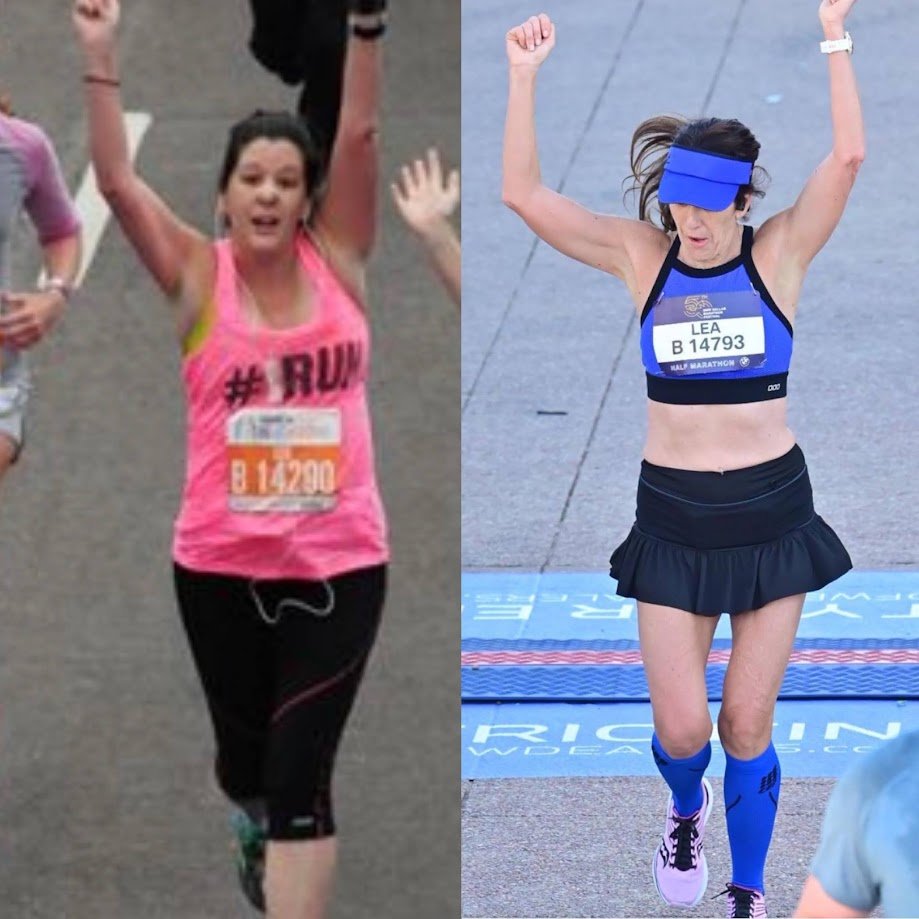Running burns more calories per minute than almost any other exercise, so if you took up running in an attempt to lose weight, it likely was effective…at first.
The incredible fact about our body is that it adapts to the stresses we place upon it, i.e., exercise. That’s why we train. The first time you ever ran around the block, you were probably out of breath by the time you reached the first corner. But if you continued to train, your body adapted, and then you were able to run a bit farther and a bit faster. Hooray for adaptation.
Adaptation is the reason we can train to run marathons and faster 10Ks. If our body did not adapt to the stresses we placed upon it; we would never improve from our training.
The downside of adaptation is that when we began and were huffing to puffing to run a mile, our body was burning a lot of calories to perform that work. As we adapted, our bodies because more efficient in the movements, and we burned fewer calories when running the same mile.
Then we lost some weight, hooray. But the more that you weigh, the more calories you burn. So you became more efficient in the movement and lost weight, so you burned even fewer calories than before.
If you lost weight while running, but did not take steps to preserve your muscle tissue, then you likely lost muscle along with fat and lowered your metabolism. A lower metabolism needs fewer calories to operate, so you need to eat less to maintain the calorie deficit that is required to continue to lose weight.
If you are eating the same amount of calories as you were when you first started losing weight, your weight loss could stall because you are burning less due to your smaller size, less muscle, and your more efficient workouts. That is why you likely stopped seeing weight loss results from running.
What Can I Do To Keep Progressing With Weight Loss?
Never fear, you can keep the weight loss progressing by increasing the volume or intensity of your workouts to continue to make new adaptations. If you have always run three miles a day, raising it to four can help keep weight loss moving. If you run at a higher intensity by including running intervals or hills instead of running the same pace and elevation, you can start to make progress again.
Then you can cut a few more calories from your diet, but don’t overdo it. Cutting too many calories can stall performance and make you feel terrible.
What If It Stops Working And My Weight Loss Stalls Again?
This works for a while, and if you are new to your weight loss journey, it’s an OK place to start. But if you have been running and dieting for years, you eventually reach a limit on how much you can run, and how few calories you can eat.
You end up making yourself miserable trying to run an hour (or more) a day while continuing to reduce calories so that you can see new weight loss. It’s not fun, and it’s not sustainable. You eventually max out on what is possible. You can’t add more miles and reduce calories forever. You reach a point that it is no longer healthy.
You don’t want to live a life where you have to run for hours a day and eat very few calories. It’s not good for your metabolism, and it’s not healthy long-term.
There’s a better way to continue to see weight loss results without literally running yourself into the ground.
Wait. Lea? Aren’t you a running coach? Are you saying I shouldn’t run for weight loss?
I am not saying that at all. Running can be a great tool in weight loss and weight management; it just can’t be the only tool.
Running too much and eating too little sets you up for a rebound in weight gain. Can you get hurt running and not be able to run at all? Will you get sick from over-training? Will you restrict your diet so much that you eventually break and will not be able to stop overeating? How do I know? All of these things happened to me.
The reason I am a running coach that teaches her clients and blog readers not to only run for weight loss is that I went down that path, and it doesn’t work for long-term sustainable results. It can lead to yo-yo weight loss and gain, frustration, and injury.
Diminishing returns is when you do more work but get less effective results. More is not always better. Sometimes to continue to see weight loss results from running, you don’t need to run more, you need to train smarter.
The key is to find the balance of the right kind of training and calories to continue to see results before diminishing returns.
CREATE A CALORIE-DEFICIT
To lose weight, you must be in a calorie deficit, which means you burn more calories than you take in. We burn most of our calories in a day just by being alive; this is called your metabolic rate: the number of calories our body spends to keep us alive.
It seems straight-forward, but how many calories you burn is a moving target, and we don’t know exactly, outside of expensive testing (and even then it can change).
So a lot of our calorie counting is in stride. We know we need to reduce calories to lose weight but by how much? The only way to know is to experiment by making small reductions in calories, or increase in exercise until we see the results we desire.
Note that I said small because drastic cuts in calories and significant increases in exercises will likely backfire in the same way if you turned up the heat in the oven to bake a cake faster. That’s not how it works with baking, and that’s not how it works in your body.
We want to create a small calorie deficit, which will require some experimentation with your nutrition and exercise programming. Pay attention to the results and continue to adjust until you get the results you desire.
INCLUDE RESISTANCE TRAINING
The exercises we do is a small percentage of the calories we burn. Yes, running can burn a lot of calories, but as we discussed above, you reach a point when you can’t increase volume or intensity further without diminishing returns.
Resistance training is a solution in two ways.
One: If you perform resistance training exercises while you are working to lose weight, you increase the chance that you maintain (not lose) the muscle mass you already have. Remember, if you lose muscle, you lower your metabolism, and your body requires fewer calories to stay alive and burns fewer calories all around. I.e., you can need to eat even less to continue to remain in a calorie deficit. Muscle is our friend!
Two: We want to maintain, and ideally, build muscle tissue, so we burn more calories all day long just by living, rather than spending hours a day trying to burn calories manually.
Resistance training should be the foundation of any weight loss program. The misconception, especially among women, is that muscle will make them bulky.
Muscle gives you shape, which why some people call it toning. Those extremely muscular women that you see in bodybuilding magazines train specifically to look that way, it doesn’t happen by accident, or easily. You won’t look that way if A) you don’t train that way. B) You are not exceptionally genetically gifted. C) You don’t take performance-enhancing drugs.
Lifting dumbbells, kettlebells, using resistance bands, medicine balls, or barbells will improve your body composition and fat-burning ability. Remember that heavy lifting is a relative term. You will see results when you lift heavy weights. For some, this may be 15-pound dumbbells, for others fifty.
Lifting heavy means heavy to you. Not too light. Not too heavy.
Adaptation in resistance training allows you to continue to lift more weight as you get stronger. So start as small as you need to and gradually increase over time for the best results.
Muscle takes up less space in the body than fat. If you lose five pounds of fat while gaining five pounds muscle, your scale weight will be the same, but your size will be smaller, your body composition improved, and you will burn more calories at rest because muscle tissue burns more calories at rest than fat tissue.
“Well, I said it once before, but it bears repeating now:” Resistance training should be the foundation of any weight loss program.
INCREASE PROTEIN INTAKE
Protein intake is essential for runners and weight loss. If you are a runner, your protein requirements are higher than a sedentary individual. If you want to avoid muscle loss while running, adequate protein intake will help to preserve your current muscle tissue. If you train to gain muscle with resistance training to improve your body composition, you need even more protein.
The amount of protein you need varies from athlete to athlete, so I suggest evaluating each meal and snack that you consume in a day to make sure you are intentional about including a whole-food protein source each time.
An excellent place to begin is .6 to 1 gram of protein per pound of body weight and adjust based on how you feel and perform.
Dairy products such as cottage cheese and Greek yogurt, and meat like poultry, turkey, beef are all complete proteins and make excellent choices for increasing protein intake. Affiliate link—->A high quality protein shake can fill in the gap if you are struggling to get enough protein in your diet from whole foods.
APPLY THE APPROPRIATE AMOUNT OF RUNNING EXERCISE
Now, after diet and strength training has been applied, the appropriate amount of running or other cardio exercises can be applied. We want the minimum effective dose: The least we can do to see results because more isn’t always better and can be detrimental.
Also, the minimum effective dose doesn’t mean the minimum period. It’s not about doing as little as possible, but the minimum you need to get results. See the difference?
Not too much, not too little. Like Goldilocks.
For best results, alternate between long slow runs, and short, fast ones. Some people get great results from running intervals once a week. Make sure you are recovering from your workouts because, without adequate recovery, you don’t improve. You get stronger, faster, and fitter in the rest period after the workout, not during the workout itself. If you sacrifice rest and recovery in the name of doing more work, you risk sacrificing the very thing you are working so hard for— results.
DAILY MOVEMENT
Moving your body in between long bouts of sitting can improve your posture, mobility, health, and help you reach your goals. I park my car in the farthest parking spot away from the front door, take the stairs whenever possible, use the restroom on another floor at the office, and walk my dogs at least once a day. These small acts of intentional movement add up over time. It doesn’t seem like much to take the stairs, but do it every day for a year, and it adds to your positive results.
I am a running coach that recommends running as a tool for weight loss but do not neglect resistance training and nutrition as top priorities in your journey. If you tried endless running and calorie cutting that stopped working, train smarter to continue to see results.
Did you like this post? Do you know someone who might benefit? It helps me when you share with your friends and followers on Facebook, Twitter, or Pinterest.
Questions? I’d love to help.














